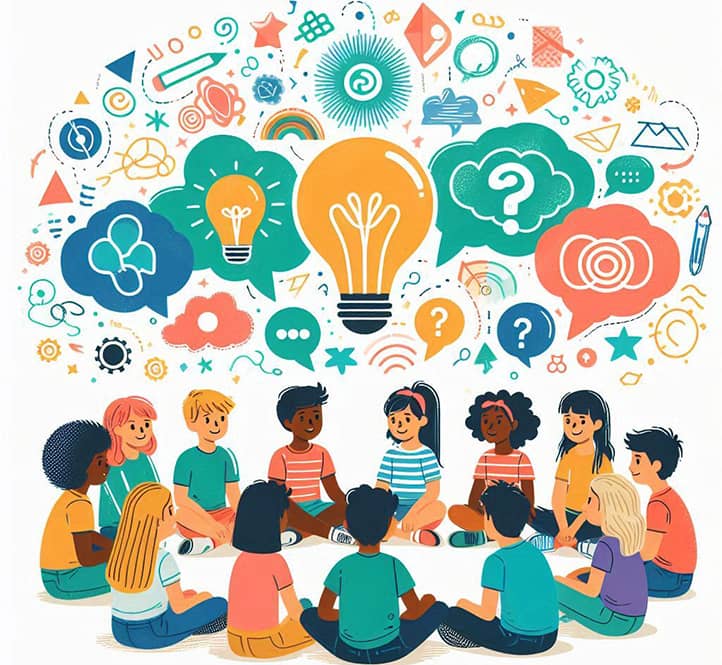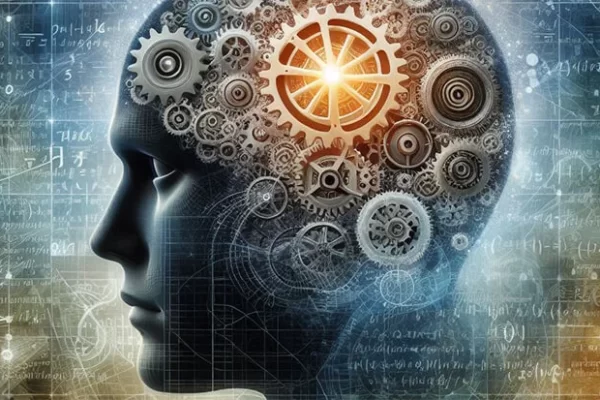In a world where information is becoming increasingly complex and multifaceted, the ability to engage in abstract thinking gains exceptional value. But what exactly is abstract thinking, and why is it so important?
Abstract thinking is a cognitive process that allows a person to operate with ideas and concepts that have no physical embodiment. It’s the ability to see general patterns, go beyond concrete examples, and create new ideas based on existing knowledge.
The significance of abstract thinking is hard to overestimate. It plays a key role in the development of science, philosophy, art, and technology. Abstract thinking enables us to:
- Solve complex problems by looking beyond obvious solutions.
- Understand and create complex theories and concepts.
- Develop creativity and innovative thinking.
- Improve critical analysis and decision-making skills.
In today’s world, where automation and artificial intelligence increasingly handle routine tasks, the ability to think abstractly becomes one of the essential skills for career success and personal growth.

Characteristics of Abstract Thinking
Abstract thinking, like a crystal with many facets, reflects various aspects of human intelligence. It allows us to create imaginary worlds populated by ideas and concepts that exist only in our minds. This incredible ability underlies not only scientific discoveries and philosophical insights but also the everyday decisions we make.
Just as an artist mixes colors on a palette to create new shades, abstract thinking enables us to combine and transform ideas, giving rise to innovation. It allows us to see the invisible, hear the unheard, and understand the incomprehensible, pushing the boundaries of our knowledge.
To better understand the essence of abstract thinking, let’s examine its main characteristics.
Ability to Generalize
One of the key features of abstract thinking is the ability to generalize information. This means the capacity to identify common features in different objects or situations and form broader concepts based on them.
For example, we can generalize the concepts of “table,” “chair,” and “cabinet” to the more abstract category of “furniture.” Or, by observing various animals, we can form the general concept of “living being.”
The ability to generalize allows us to:
- Systematize knowledge.
- Identify connections between different phenomena.
- Create classifications and taxonomies.
- Formulate laws and theories.
Ability to Identify Essential Features
Another important characteristic of abstract thinking is the ability to identify the most important, essential features of objects or phenomena, disregarding secondary details.
This skill is critical for:
- Analyzing complex situations.
- Making well-informed decisions.
- Creating models and theories.
- Understanding the core of problems and phenomena.
For instance, when analyzing an economic situation, abstract thinking allows us to highlight key factors affecting the economy while ignoring many less significant details.
Operation with Symbols and Concepts
Abstract thinking is closely linked to the use of symbols and concepts. It’s the ability to operate with ideas that lack direct physical embodiment.
Examples include:
- Mathematical symbols and formulas.
- Philosophical concepts.
- Scientific theories.
- Abstract artistic images.
The ability to work with symbols and concepts allows us to:
- Create complex theories and models.
- Develop logical thinking.
- Effectively express complex ideas.
- Develop creative thinking.

Developing Abstract Thinking
The path to abstract thinking resembles a climb up a mountain: each step reveals new horizons of understanding. This process begins with a child’s early questions of “why?” and continues throughout life, constantly expanding our perception of the world.
Just as muscles strengthen with regular training, the ability to think abstractly develops through constant practice and intellectual challenges. Every solved puzzle, every read book, every discussion contributes to the formation of this critical skill.
Abstract thinking is not an innate ability. It gradually develops as a person grows and learns.
Stages of Development in Ontogeny
The development of abstract thinking goes through several key stages:
- Sensorimotor stage (0-2 years): A child learns about the world through physical actions and sensory experiences.
- Preoperational stage (2-7 years): Symbolic thinking appears, but logic is not yet developed.
- Stage of concrete operations (7-11 years): The child begins to think logically but only about concrete objects.
- Stage of formal operations (from 11-12 years): The ability for abstract thinking, hypothetical reasoning, and analysis develops.
It’s worth noting that not everyone reaches the full development of abstract thinking, and this process can continue into adulthood.
Methods and Exercises for Developing Abstract Thinking
The good news is that abstract thinking can be developed and improved throughout life. Here are some effective methods:
- Reading complex literature: philosophical works, science fiction, classical literature.
- Studying mathematics and logic: solving problems, puzzles, and logical paradoxes.
- Art analysis: discussing abstract paintings, modern music, experimental cinema.
- Meditation and reflection: practices that develop self-observation and analysis of one’s own thoughts.
- Learning new languages: this enhances the ability to think in different symbolic systems.
- Role-playing and modeling situations: help develop mental flexibility and the ability to forecast.
- Writing essays and analytical articles: improves skills in structuring thoughts and argumentation.
Regular practice of these exercises can significantly improve the ability to think abstractly.

Role of Abstract Thinking in Various Fields
Abstract thinking permeates all aspects of human activity, like an invisible thread connecting various areas of knowledge and creativity. It serves as a bridge between the concrete and the imaginary, the known and the unknown, opening new avenues for exploration and innovation.
In today’s world, the ability to think abstractly becomes a key skill for navigating the ocean of data and ideas. It allows us to see patterns where others see only chaos and to find simplicity in apparent complexity.
Abstract thinking plays a crucial role in many fields of human activity. Let’s look at some of them in more detail.
Science and Philosophy
In science and philosophy, abstract thinking is a fundamental tool for understanding the world.
In science, it allows us to:
- Formulate hypotheses and theories.
- Create mathematical models.
- Interpret experimental data.
- Predict new phenomena.
For example, Einstein’s theory of relativity or quantum mechanics are the results of deep abstract thinking that changed our understanding of the universe.
In philosophy, abstract thinking is essential for:
- Analyzing complex concepts (existence, consciousness, free will).
- Creating ethical systems.
- Developing logical arguments.
- Exploring the nature of knowledge and reality.
Art and Creativity
Abstract thinking plays a key role in art, especially in its modern forms.
It allows artists to:
- Create new configurations.
- Experiment with color, shape, and sound.
- Convey complex emotions and ideas through abstract images.
- Find unexpected connections between different concepts.
Examples include abstract painting, atonal music, experimental poetry, and conceptual art.
Problem-Solving in Everyday Life
Abstract thinking is not limited to high spheres of science and art. It plays an important role in everyday life, helping us to:
- Plan for the future and set long-term goals.
- Analyze complex situations and make decisions.
- Find creative solutions to everyday problems.
- Understand and interpret social norms and rules.
For instance, when planning a budget, we use abstract thinking to forecast future expenses and income.

Connection with Other Cognitive Processes
Abstract thinking does not exist in a vacuum; it is intricately intertwined with other cognitive processes, forming a complex symphony of the mind. Just as various instruments in an orchestra create harmonious sound, the interaction of abstract thinking with memory, attention, and perception shapes each person’s unique cognitive landscape.
This interaction can be compared to an ecosystem, where each element influences and depends on others. The development of one cognitive process inevitably leads to changes in others, creating a dynamic system of constant growth and adaptation.
Interaction with Memory
Memory and abstract thinking mutually reinforce each other:
- Memory provides material for abstract thinking.
- Abstract thinking helps structure and generalize memories.
- The creation of abstract concepts makes information easier to remember.
- Memories can stimulate new abstract ideas.
For example, when studying history, we not only remember facts but also form abstract representations of social and political processes.
Influence on Perception
Abstract thinking significantly affects how we perceive the world:
- It enables us to interpret sensory data within the context of broader concepts.
- Helps us focus on significant stimuli within streams of information.
- Shapes expectations that, in turn, affect perception.
- Allows us to “see” abstract patterns and regularities in the environment.
For instance, the ability to recognize emotions from facial expressions results from abstract generalization of numerous visual signals.
Role in the Learning Process
Abstract thinking plays a critical role in the learning process:
- It helps connect new information with existing concepts.
- Enables the transfer of knowledge from one field to another.
- Fosters a deep understanding of the material being studied.
- Stimulates critical thinking and analysis.
The development of abstract thinking is one of the main goals of education, especially at higher levels. It enables students not only to memorize facts but also to understand fundamental principles and patterns.

Disorders of Abstract Thinking
The ability for abstract thinking, so fundamental to human intelligence, can be fragile and vulnerable. Like a finely tuned instrument, it can be disrupted by various factors, from neurological diseases to psychological trauma.
Disorders in abstract thinking can manifest in different ways, from barely noticeable changes to profound transformations in worldview. They remind us of the complexity and sensitivity of the human mind, emphasizing the importance of mental health care.
Causes and Symptoms
Disorders in abstract thinking may arise from various causes:
- Neurological diseases (such as Alzheimer’s disease, schizophrenia, autism).
- Brain injuries.
- Mental disorders (such as depression, anxiety).
- Lack of education or stimulation.
- Chronic stress.
- Alcohol or drug abuse.
Symptoms of impaired abstract thinking may include:
- Difficulty understanding metaphors and analogies.
- Inability to identify key points in complex information.
- Problems with planning and goal setting.
- Literal interpretation of language.
- Difficulty solving non-standard problems.
- Rigid thinking, with inability to approach flexibly.
Impact on Life
Impairments in abstract thinking can significantly affect a person’s quality of life:
- Hinder learning and professional development.
- Complicate social interactions.
- Limit problem-solving ability.
- Reduce creativity and innovative thinking.
- Can lead to difficulties in daily life (e.g., planning a budget or organizing time).
It is worth noting that many of these impairments can be corrected with special exercises and therapy, especially if detected early.

Contemporary Research on Abstract Thinking
The study of abstract thinking in the 21st century resembles exploring a new galaxy: every discovery generates many new questions. Modern neuroimaging technologies allow us to observe the brain in action, observing the neural “constellations” activated during abstract thought.
An interdisciplinary approach, combining neurobiology, psychology, philosophy, and computer science, opens new horizons in understanding this unique aspect of human intelligence. Each new study adds a new brushstroke to our understanding of abstract thinking, gradually forming an increasingly complete picture of this remarkable phenomenon.
Science does not stand still, and research into abstract thinking continues to push the boundaries of our understanding of this essential cognitive process.
Neurobiological Foundations
Modern neuroimaging methods allow us to better understand how abstract thinking is realized in the brain:
- Studies show that abstract thinking activates various brain regions, including the prefrontal cortex, parietal lobe, and certain subcortical structures.
- The left hemisphere plays a particularly important role, especially in verbal abstractions.
- The right hemisphere is more active in visual abstractions.
- Neural networks involved in abstract thinking are closely linked with those responsible for working memory and attention.
These studies help us better understand how abstract thinking develops and how it can be enhanced.
New Theories and Approaches
Contemporary research not only deepens our understanding of the neurobiological foundations of abstract thinking but also offers new theoretical approaches to its study:
- Embodied Cognition Theory suggests that abstract thinking is closely tied to our physical experiences. For example, we often use spatial metaphors to describe abstract concepts (“high ideals,” “deep thoughts”).
- Predictive Coding Theory posits that the brain continuously creates abstract models of the world and uses them to predict future events. Abstract thinking in this context is viewed as a key mechanism for creating and updating these models.
- Dual Process Theory suggests that there are two systems of thinking: a fast, intuitive System 1 and a slow, analytical System 2. Abstract thinking is mainly associated with System 2.
- Cross-Domain Integration examines how abstract thinking allows us to integrate information from different fields of knowledge, creating new ideas and concepts.
These theories open up new perspectives for understanding and developing abstract thinking.

Conclusion
Abstract thinking represents one of the most remarkable abilities of the human mind. It allows us to go beyond concrete experience, create new ideas and concepts, solve complex problems, and understand the fundamental laws of the universe. This cognitive process plays a key role in science, philosophy, art, and everyday life, constantly expanding the boundaries of our understanding of the world.
The development of abstract thinking is a lifelong process that begins in early childhood and can continue throughout life. It is closely connected with other cognitive functions, such as memory, perception, and learning, forming a complex system of interactions in our brain. Understanding these connections opens new opportunities for improving educational methods and therapeutic approaches.
Contemporary research in neurobiology and cognitive science continues to deepen our understanding of abstract thinking. New theories and approaches, such as embodied cognition and predictive coding, offer fresh perspectives for studying this phenomenon. This research not only expands our knowledge of brain function but also opens new horizons in artificial intelligence and cognitive technology.
The ability for abstract thinking is not just a cognitive skill; it is the key to our ability to dream, invent, and evolve as a species. By continuing to study and develop this unique human capacity, we open the door to a future full of limitless possibilities. Abstract thinking remains one of the most exciting and promising areas of research in cognitive science, promising new discoveries and innovations that could change our understanding of the mind and consciousness.
Recommended Literature
- “How the Mind Works” — by Steven Pinker. The author explains how cognitive processes, including abstract thinking, function and how they affect our perception and understanding of the world.
- “Brain Rules: 12 Principles for Surviving and Thriving at Work, Home, and School” — by John Medina. This book examines how the brain processes abstract concepts and how these processes contribute to idea creation and problem-solving.
- “The Brain: The Story of You” — by David Eagleman. This book explores how the brain handles abstract thinking and how this affects our understanding of the surrounding world.
- “Thinking, Fast and Slow” — by Daniel Kahneman. The book describes the interplay of intuitive and abstract thinking and how they can be used for decision-making in uncertain situations.




